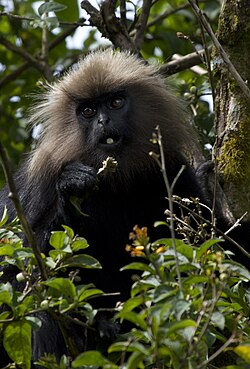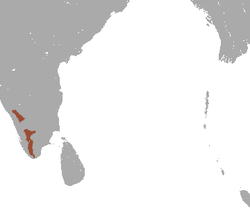| Nilgiri langur | |
|---|---|
 | |
| Nilgiri langur eating fruit. | |
 | |
| At Parambikulam. | |
| Scientific classification | |
| Kingdom: | Animalia |
| Phylum: | Chordata |
| Class: | Mammalia |
| Order: | Primates |
| Suborder: | Haplorhini |
| Infraorder: | Simiiformes |
| Family: | Cercopithecidae |
| Genus: | Semnopithecus |
| Species: | S. johnii |
| Binomial name | |
| Semnopithecus johnii (J. Fischer, 1829) | |
 | |
| Nilgiri langur range | |
| Synonyms [2] | |
| |
The Nilgiri langur (Semnopithecus johnii) is an Asian langur of the Old World monkey. It has glossy, black fur and an orangey-golden brown, hair-like mane on its head. Females have a white patch of fur on the inner thigh. It typically lives in troops of nine to ten individuals, with or without offspring, depending on seasonality. Its diet consists of fruits, shoots and leaves. It is listed as vulnerable on the IUCN Red List and is threatened by habitat destruction and poaching for its body parts, thought to supposedly contain aphrodisiac properties.
